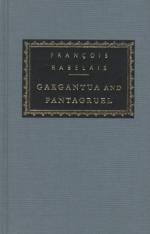When, as has been done for Moliere, a critical bibliography of the works relating to Rabelais is drawn up—which, by the bye, will entail a very great amount of labour—the easiest part will certainly be the bibliography of the old editions. That is the section that has been most satisfactorily and most completely worked out. M. Brunet said the last word on the subject in his Researches in 1852, and in the important article in the fifth edition of his Manuel du Libraire (iv., 1863, pp. 1037-1071).
The facts about the fifth book cannot be summed up briefly. It was printed as a whole at first, without the name of the place, in 1564, and next year at Lyons by Jean Martin. It has given, and even still gives rise to two contradictory opinions. Is it Rabelais’ or not?
First of all, if he had left it complete, would sixteen years have gone by before it was printed? Then, does it bear evident marks of his workmanship? Is the hand of the master visible throughout? Antoine Du Verdier in the 1605 edition of his Prosopographie writes: ‘(Rabelais’) misfortune has been that everybody has wished to “pantagruelize!” and several books have appeared under his name, and have been added to his works, which are not by him, as, for instance, l’Ile Sonnante, written by a certain scholar of Valence and others.’
The scholar of Valence might be Guillaume des Autels, to whom with more certainty can be ascribed the authorship of a dull imitation of Rabelais, the History of Fanfreluche and Gaudichon, published in 1578, which, to say the least of it, is very much inferior to the fifth book.




